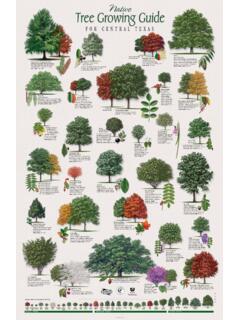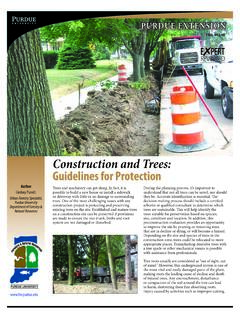Transcription of Urban Street Design Guide - New York City
1 UrbanStreetDesignGuideOVERVIEWOCTOBER 2012 New Orleans, LA3 NACTO Urban Street Design Guide Overview ContentsForewordUrban Street Design Guide OutlineFive Principles of Urban Street DesignStreets and Intersections Very Large Streets Transit Streets Medium Streets Act Now! Very Small Streets Alleys & PassagewaysCritical Issues Speed and Safety Design vs. Target Speed Treatments & Elements Moving the Curb Low-Impact Design Parklets, Pop-ups and Street SeatsAcknowledgments45681012141618202224 26 2830323435 National Association of city Transportation Officials55 Water St., Floor 9 New york , NY Urban Street Design Guide Overview Designing Streets as Public SpacesThe NACTO Urban Street Design Guide charts the Design principles and strategies that cities are adopting to confront 21st Century demands on their streets.
2 It is based on the fundamental idea that streets are spaces for people as well as arteries for traffic. The Guide is rooted in on-the-ground, built projects and great streets, and reflects international best practices and research in Urban Design , planning and large cities across the United States have already changed the way they build streets. Roadways once conceived singularly as arterials for traffic have been recast and retrofitted as public spaces crucial to the economic success, safety and vitality of the city . Sidewalks are expanding to provide space for children playing, strollers, a growing population of older people and people of all ages just out for a walk. city transportation departments are mak-ing space for bicycles and transit in the Street , whether through bike paths, light-rail corri-dors or bus rapid innovations are at the center of improvements for Urban roadways in the US, but they are still often treated as marginal or exceptional by other national Design guides.
3 This Guide will fill that gap and give cities the tools they need as they strive to make the most of their streets. New york , NY Janette Sadik-Khan NACTO President Commissioner, New york city Department of TransportationForeword5 NACTO Urban Street Design Guide Overview What s to ComeOutline for the 2013 NACTO Urban Street Design GuideStreets and Intersections Very Large Streets Large Streets Medium Streets Small Street Very Small Streets Alleys and Passageways Pedestrian Streets Shared Streets and Home Zones Transit Streets Complex Intersections Compact Intersections Reorganizing Intersections Multi-leg Intersections Public PlazasCritical Issues Speed and Safety Design vs.
4 Target Speed Corner Design and Turning Radii Lane Width Transit Lanes Crosswalks and Crossings Level of Service Curbside Management Design and Control Vehicle Functional Classification One-way vs. Two-way Traffic Control Devices Visibility and Sightlines Clear Zones Access Management DrivewaysTreatments & Elements Parklets, Pop-ups & Street Seats Low Impact Design Moving the Curb Bus Stops Stormwater Management Parking Sidewalk ConfigurationsThe NACTO Urban Street Design Guide has been orga-nized to analyze the Street from multiple perspectives, from the bird s eye view to the granular details. This overview is the first product in the development of a Design Guide for Urban streets. The chapters highlight-ed here illustrate some of the greatest Street Design practices around the country and synthesize these national efforts.
5 Street network Design principles will be discussed mainly as they relate to the Design of individual cor-ridors. Materials, lighting and Street furniture are de-emphasized here due to their inherently local charac-ter and application. The NACTO Urban Street Design Guide is slated for release in Summer 2013. Items highlighted in bold are discussed in this overview. 6 NACTO Urban Street Design Guide Overview Streets are Public SpacesStreets are often the most vital, yet underutilized public spaces in cities. Conventional highway Design standards tend to look at streets as thoroughfares for traffic and measure their performance in terms of speed, delay, throughput and congestion. In real-ity, streets play a much larger role in the public life of cities and communities and should be designed to include public spaces as well as channels for Streets are Great for BusinessCities have realized that streets are an economic as-set as much as a functional element.
6 Well-designed streets generate higher revenues for businesses and higher values for homeowners. Five Principles of Urban Street DesignWashington, DCSanta Barbara, CADesigning world-class streets begins with a restatement of the problem and the means by which to understand that problem. These five principles establish a clear understanding of the primary goals, ideals and tenets of world-class Street Urban Street Design Guide Overview Design for SafetyIn 2010, 32,885 people were killed in traffic crashes, which are also the leading cause of death among children aged 5 to 14. These deaths and hundreds of thousands of injuries are avoidable. Traffic engineers can and should do better, by designing streets where people walking, parking, shopping, bicycling, working and driving can cross paths can be ChangedTransportation engineers can work flexibly within the building envelope of a Street .
7 This includes moving curbs, changing alignments, daylighting corners and redirecting traffic where necessary. Many city streets were created in a different era and need to be recon-figured to meet new needs. Street space can also be reused for different purposes, such as parklets, bicycle parking and pop-up Now!Implementing projects quickly using temporary mate-rials helps inform public decision making. Cities across the US have begun using a stepped approach to major redesigns, where temporary materials are used in the short term, to be replaced by permanent materials after the public has tested the Design campaign in New york CityBrooklyn, NYNew york , NY8 NACTO Urban Street Design Guide Overview STREETS & INTERSECTIONSC onventional Street Design has historically favored the function of movement over that of place.
8 The NACTO Urban Street Design Guide considers Street Design as a balance of these two needs and safety as the driving parameter in Design . The Guide uses Street width and dimension as a primary point of departure. Width is a limiting factor in Design when considering the re-organization of a given corridor. The Guide has been organized accordingly, ranging from Very Large Streets to Very Small Streets. This organization deviates from conventional practice, which is limited by functional classification or an alternative classification scheme, usually based on context. Many local jurisdictions have established their own classi-fication criteria. Using width as opposed to type or class allows for the Street to be analyzed foremost as a container and a public space, with context, land use and traffic as forces that together shape that space.
9 In select cases, the Guide will highlight special streets, such as shared streets and transit streets, which focus on specific Street users and contexts. The Intersections portion of the Guide will highlight both spatial and tem-poral Design strategies, focusing on how cities can make junctions safer for everyone using the Street . StreetsStreets are critical arteries for transporting goods and people, but they are also the places where we live, work, play and interact. The Design and management of an Urban Street must reflect and accommodate these diverse and competing uses. The layout and op-eration of streets can prioritize and enhance particular uses for the benefit of all. This chapter presents streets by width, from wide to narrow. It illustrates innovative designs that meet the varying and changing needs of Urban streets.
10 This includes: Fundamental safety and operational strategies The spatial qualities of the Street , from building line to building line The relationship between land use and traffic Management strategies for parking and other curbside uses Flexibility of Street use during the course of a day, week or yearIntersectionsAn intersection is any place where different users mix and compete for time within the same space. Inter-sections take many forms and shapes, ranging from complex junctions to driveways to the meeting of two paths. They are often defined by their layout and operations: traffic signals, roundabouts, T-junctions. Simplicity, compactness, low speed and eye contact are favored in intersection chapter presents intersections as extensions of streets.

















